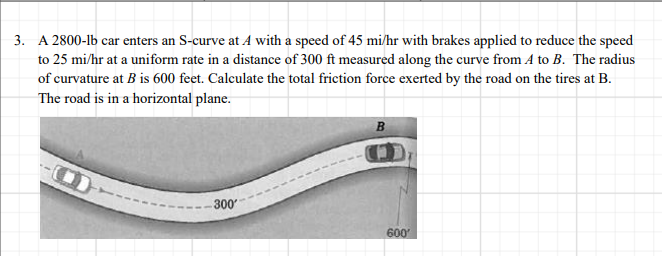3. A 2800-lb car enters an S-curve at A with a speed of 45 mi/hr with brakes applied to reduce the speed to 25 mi/hr at a uniform rate in a distance of 300 ft measured along the curve from A to B. The radius of curvature at B is 600 feet. Calculate the total friction force exerted by the road on the tires at B. The road is in a horizontal plane. 300 600'
3. A 2800-lb car enters an S-curve at A with a speed of 45 mi/hr with brakes applied to reduce the speed to 25 mi/hr at a uniform rate in a distance of 300 ft measured along the curve from A to B. The radius of curvature at B is 600 feet. Calculate the total friction force exerted by the road on the tires at B. The road is in a horizontal plane. 300 600'
Physics for Scientists and Engineers with Modern Physics
10th Edition
ISBN:9781337553292
Author:Raymond A. Serway, John W. Jewett
Publisher:Raymond A. Serway, John W. Jewett
Chapter6: Circular Motion And Other Applications Of Newton's Laws
Section: Chapter Questions
Problem 44AP: A model airplane of mass 0.750 kg flies with a speed of 35.0 m/s in a horizontal circle at the end...
Related questions
Topic Video
Question

Transcribed Image Text:3. A 2800-lb car enters an S-curve at A with a speed of 45 mi/hr with brakes applied to reduce the speed
to 25 mi/hr at a uniform rate in a distance of 300 ft measured along the curve from A to B. The radius
of curvature at B is 600 feet. Calculate the total friction force exerted by the road on the tires at B.
The road is in a horizontal plane.
B
300
600
Expert Solution
Step 1
mass of the car m = 2800 lb = 1270.059 Kg
initial velocity of car u = 45 mi/hr = 20.1168 m/s
final velocity of car v = 25 mi/hr = 11.176 m/s
Distance s = 300 ft = 91.44 m
Radius of curvature= 600 ft
We know from the third equation of motion calculating acceleration from A to B in tangential direction
Now we are calculating acceleration of car at normal
Trending now
This is a popular solution!
Step by step
Solved in 2 steps

Knowledge Booster
Learn more about
Need a deep-dive on the concept behind this application? Look no further. Learn more about this topic, physics and related others by exploring similar questions and additional content below.Recommended textbooks for you

Physics for Scientists and Engineers with Modern …
Physics
ISBN:
9781337553292
Author:
Raymond A. Serway, John W. Jewett
Publisher:
Cengage Learning

College Physics
Physics
ISBN:
9781285737027
Author:
Raymond A. Serway, Chris Vuille
Publisher:
Cengage Learning

Principles of Physics: A Calculus-Based Text
Physics
ISBN:
9781133104261
Author:
Raymond A. Serway, John W. Jewett
Publisher:
Cengage Learning

Physics for Scientists and Engineers with Modern …
Physics
ISBN:
9781337553292
Author:
Raymond A. Serway, John W. Jewett
Publisher:
Cengage Learning

College Physics
Physics
ISBN:
9781285737027
Author:
Raymond A. Serway, Chris Vuille
Publisher:
Cengage Learning

Principles of Physics: A Calculus-Based Text
Physics
ISBN:
9781133104261
Author:
Raymond A. Serway, John W. Jewett
Publisher:
Cengage Learning

University Physics Volume 1
Physics
ISBN:
9781938168277
Author:
William Moebs, Samuel J. Ling, Jeff Sanny
Publisher:
OpenStax - Rice University

College Physics
Physics
ISBN:
9781938168000
Author:
Paul Peter Urone, Roger Hinrichs
Publisher:
OpenStax College

Physics for Scientists and Engineers
Physics
ISBN:
9781337553278
Author:
Raymond A. Serway, John W. Jewett
Publisher:
Cengage Learning